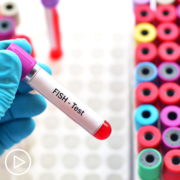What Is Minimal Residual Testing in Multiple Myeloma?
What is Minimal Residual Testing in Multiple Myeloma? from Patient Empowerment Network on Vimeo.
How is minimal residual testing (MRD) used for multiple myeloma patients? Watch as expert Dr. Nina Shah explains the use of MRD testing, and myeloma patient and Empowerment Lead Lisa Hatfield shares her knowledge of MRD testing and how specialists use it in treatment and care.
See More from START HERE Myeloma
Related Resources:

|

|

|
Transcript:
Dr. Nina Shah:
Minimal residual disease is exactly what it sounds like. It’s the disease that you can’t see under the microscope, but it’s still there. And I sort of equate it to the little deep food particles that are in a pot after you clean it and really, really scrub it, but still, something is in there. And that’s what it is for myeloma.
Minimal residual disease testing, or MRD testing, is performed to locate any small number of cancer cells that remain in the cancer patient’s bone marrow during or following treatment. The presence of any remaining cancer cells is the most common cause of relapse in blood cancers, so MRD testing is used to gauge treatment success, to compare different treatments, to detect myeloma recurrence, to monitor patient remission, and to help choose optimal treatments.
Lisa Hatfield:
So when I was first diagnosed, MRD testing, or minimal residual disease testing, sometimes called measurable residual disease testing, was just, they were looking at having it approved by the FDA for clinical trials only. Still it was only approved for clinical trials as an end point. However, a lot of myeloma specialists are using this MRD testing to help guide decisions. It’s not approved for that yet but to help guide decisions for patients who have a really great response to their induction chemo and stem cell transplant that they may have after induction chemo and after some years of maintenance to see if they can possibly go off of their maintenance therapy. It is occasionally being used, MRD testing, is being used to help guide providers and patients on where to go with treatment. So MRD testing requires a bone marrow biopsy. The most sensitive MRD testing is called clonoSEQ testing, it is NGS testing. It does require the original bone marrow sample, and then they can track that over time each year or however often you have bone marrow biopsies to see if the cloned cells are still there.
So MRD testing right now requires the bone marrow biopsy. I’m hoping that someday it can be done with a blood test, but it’s really important for tracking purposes to see if you’re responding to therapy, to see if you’re staying in remission during maintenance therapy. And it’s even worthwhile too if you’re having toxicities from maintenance therapy to consider going off of that therapy. You can test to see, right now the MRD testing is testing to see if they can find one myeloma cell out of one million cells. So it’s called 10-6 MRD testing. That’s the most sensitive test that’s out there to date and really important if you’re considering possibly going off of maintenance therapy or are having significant toxicities during your treatment.
What Is a FISH Test?
What is a FISH Test? from Patient Empowerment Network on Vimeo.
What is a FISH test for multiple myeloma patients? Watch as expert Donna Catamero explains how fluorescent in situ hybridization (FISH) testing is used, and myeloma patient and Empowerment Lead Lisa Hatfield shares her experience with FISH testing and her advice to other patients.
See More from START HERE Myeloma
Related Resources:

|

|

|
Transcript:
Donna Catamero:
So, FISH is a cytogenetic technique. So, what we do is, when we do the bone marrow, we send that off and we look at the genetics. Like I said, it’s a snapshot. And certain mutations will put patients in different risk stratifications, so we normally do this at the time of diagnosis and then with each relapse.
In a FISH test, a bone marrow biopsy is taken to map out the genetic material of a cell using fluorescent dyes. These dyes show specific parts of chromosomes and help locate genetic issues like 11;14 translocation, 17 deletion, and others that are important in determining multiple myeloma treatment. If you have not had a FISH test, make sure to ask your doctor if the test should be performed to aid in your diagnosis and treatment.
Lisa Hatfield:
The first time I heard FISH test I had no idea what my doctor was talking about. It was actually a nurse practitioner who works with my myeloma specialist who said, “Your FISH test came back, and you have two abnormalities. One of them is called translocation 11;14, standard risk. And one is called monosomy 13, which sometime in the past used to be considered a higher risk but apparently it’s not anymore.” She was trying to explain this to me. I had no idea what she meant what a FISH test was. As time went on and I started to study a little bit more, do a little bit more research on myeloma, I understand the significance and the importance of having a FISH test done for anyone who’s getting diagnosed at a local hospital or community cancer center. I encourage everyone to make sure they can have a FISH test done even if that means consulting with a myeloma specialist to ensure that they can find those cytogenetic abnormalities or to test for those. Because that will help guide your treatment and your prognosis going forward. You want to know what those cytogenetic abnormalities are. They’ll be tracking those over time. So a FISH test is kind of confusing. But without going into too much detail, it’s an interesting test that they can do. It’s very helpful if it’s done at diagnosis. Important to be done at diagnosis, so those genetic abnormalities can be tracked over time through further testing.
What Is Early MGUS?
What is Early MGUS? from Patient Empowerment Network on Vimeo.
What happens in early MGUS, or monoclonal gammopathy of undetermined significance? Watch as expert Dr. Irene Ghobrial explains MGUS and how often it progresses, and patient and Empowerment Lead Lisa Hatfield shares her advice and information about ongoing research studies on MGUS.
See More from START HERE Myeloma
Related Resources:

|

|

|
Transcript:
Dr. Irene Ghobrial:
So MGUS, or monoclonal gammopathy of undetermined significance, is a precursor or the stage before myeloma happens, and it’s actually a very common disease or entity in many, many of us as we get older. In fact, maybe 5 percent of the population over the age of 50 would have this early MGUS.”
The condition of MGUS does not usually impact a person’s health or result in any symptoms. MGUS is most often found on a routine blood test that notes a high level of protein in the blood, and additional tests show the protein is a monoclonal antibody.
Though MGUS is not a cancer, it is sometimes classified pre-malignant since some patients with MGUS eventually develop cancers such as lymphoma, multiple myeloma, or amyloidosis.
Lisa Hatfield:
So MGUS, or monoclonal gammopathy of undetermined significance, is the precursor to typically smoldering myeloma and then to multiple myeloma. Not all MGUS is going to progress to multiple myeloma. In fact, it usually does not. Also important to have a hematologist on board if you are diagnosed with MGUS. There is a study being done right now in Iceland called the iStopMM Study or the Black Swan Study where they are looking at every resident over a certain age to detect how many people in the general population have MGUS. And they follow them over time longitudinally to see how many of those patients who have MGUS will progress to smoldering myeloma and then onto multiple myeloma.
So it’s really interesting. I guess what I would say about MGUS if you’re diagnosed with MGUS, not to panic. You have a lot of time to think about it, to have a hematologist follow you. And typically MGUS, as far as I know, is not treated. It is just monitored to see if it will progress onto smoldering myeloma and then onto multiple myeloma.
What is Smoldering Myeloma?
What is Smoldering Myeloma? from Patient Empowerment Network on Vimeo.
What occurs during smoldering myeloma? Watch as myeloma expert Dr. Irene Ghobrial explains smoldering myeloma and progression, and patient and Empowerment Lead Lisa Hatfield shares her perspective of learning from smoldering myeloma patients.
See More from START HERE Myeloma
Related Resources:

|

|
Transcript:
Smoldering multiple myeloma, also known as SMM, is an early form of multiple myeloma when patients don’t experience issues or symptoms of the condition.
Dr. Irene Ghobrial:
Smoldering myeloma – and, the name says it; it’s almost myeloma, it has a higher chance of progressing to myeloma – in general, it’s about 10 percent per year, and usually, the bone marrow has more than 10 percent plasma cells…….3:04- 3:23 You want to make sure that patient is followed up carefully, and you want to offer, potentially, clinical trials because we want to prevent progression. The hope in the future is you don’t wait until you have lytic lesions, fractures in your bones, kidney failure, and then we treat. The hope is we treat you earlier, and we can make a huge difference in that early interception for myeloma.
Lisa Hatfield:
So smoldering myeloma, or SMM, smoldering multiple myeloma, is the precursor to multiple myeloma. Not every person who has smoldering is going to move right into myeloma. They have high-risk smoldering myeloma, which is not the same as high-risk multiple myeloma. It’s really important if you’re diagnosed with smoldering myeloma, to find a specialist.
And the reason why is we have a couple people in one of my support groups who were diagnosed with smoldering myeloma. And depending on the provider you talk with, some choose to treat smoldering myeloma. Some choose to watch and wait and monitor that myeloma. The other important thing to know is there are many clinical trials out there for smoldering myeloma patients. And your provider, particularly any specialists you may have contact with, even if it’s just for a consult, they can help navigate you to those clinical trials that might be best for you. Some of them require you to be close to a large medical center. Some of them allow you to live at your local location and just travel maybe once a month or once every couple of months. But it’s really important to talk to a specialist about those clinical trials to see if that would be something that would be of interest to you.
How is Multiple Myeloma Staged?
How is Multiple Myeloma Staged? from Patient Empowerment Network on Vimeo.
How is staging used in multiple myeloma? Watch as expert Dr. Abdullah Khan explains staging and its use, and myeloma patient and Empowerment Lead Lisa Hatfield shares how the use of staging and its factors have evolved over time.
See More from START HERE Myeloma
Related Resources:

|

|
Transcript:
Healthcare professionals use a combination of lab test results, imaging tests, and bone marrow exams to determine the stage of multiple myeloma. The revised International Staging System or Durie-Salmon Staging System may be used in determining a patient’s multiple myeloma stage.
Dr. Abdullah Khan:
“The patients are assigned stages I to III. To determine the ISS you need lab values for the beta-2 microglobulin and albumin. For the revised ISS, you add on the lab value for LDH, lactate dehydrogenase, and you also add in the chromosome risk profile. So, there are certain genetic changes that predict a more aggressive myeloma. And the ones added to the revised ISS staging system are translocation 4;14, translocation 14;16, and deletion 17p.”
Lisa Hatfield:
So staging with multiple myeloma is really unique. A lot of times people think that every cancer has four stages. That is not true with myeloma. There are three stages for myeloma. And even now as of this year, some providers, some oncologists are not even staging myeloma. They’re looking at the risk factors, the cytogenetic risk factors to see if you’re standard risk or high risk. They’re not even using the staging system. It’s interesting. Back when I was diagnosed back in 2018, there were two staging systems used. One was the Durie-Salmon scale. I was diagnosed as stage III, which is the highest level. Mine was based on the fact that I had a lot of bone lesions and bone involvement.
But there’s also one called R-ISS, the revised ISS staging. And that one I was staged at stage I. So it’s really important to get a myeloma specialist on board quickly, because my myeloma specialist explained why I had two different stages I was staged at. She used the R-ISS, the more current system, the stage I and also looked at my cytogenetic risk factors. So your doctor will talk to you about FISH testing. And FISH testing might show something like translocations in the myeloma cells themselves or genetic abnormalities in the myeloma cells themselves. And that helps them dictate also what your risk will be going forward and how to treat that, how to treat your myeloma as a result of those risk factors and the stage you’re diagnosed at.
Your care provider may use other criteria in determining a person’s best optimal treatment. Make sure to ask if you have additional questions.
Where Should I START Following My Myeloma Diagnosis?
Where Should I START Following My Myeloma Diagnosis? from Patient Empowerment Network on Vimeo.
What should multiple myeloma patients do following diagnosis? Watch as myeloma expert Dr. Peter Forsberg shares care and support advice, and patient and Empowerment Lead Lisa Hatfield shares support that she’s found helpful and advice for moving forward to treatment.
See More from START HERE Myeloma
Related Resources:

|

|

|
Transcript:
Being diagnosed with myeloma can be a big shock. Here are some key steps you can take from a myeloma expert:
Dr. Peter Forsberg:
I think the first thing you want to do is make sure you have a care team in place you’re comfortable with. That means support from friends and family. It also means providers you’re comfortable with. Usually you’re diagnosed by an oncologist and hopefully that’s somebody that you already feel a good comfortable relationship with.
I always think it’s worthwhile to consider getting a second opinion, another voice. And that could be even if you’re diagnosed at the most high-power academic center in the country, or whether it’s in a more community-type setting. I think having another voice just to make sure everything makes sense, that it seems fairly consistent, and that you understand things as thoroughly as you can. But you do want to get the ball rolling in terms of making a care plan and moving towards therapy if that’s the next step, without taking too much time.”
Lisa Hatfield:
Well, to start following your myeloma diagnosis, I think the first thing that has to happen is you have to allow yourself time to take in that information from your provider, to think about it, always have another person with you to take notes. Because the shock of getting a cancer diagnosis can overwhelm your mind, and having somebody with a notebook and pen and can take notes during every appointment was really critical for me. My husband went with me, and it was a huge godsend going back and looking at those notes whenever I had to go to another provider to talk about my diagnosis. So I think having a person go with you, having a good medical team, some people prefer to go on the Internet and research myeloma. I did like to do that. I probably found too much information, but it helped me come up with a plan of what type of questions to ask my providers and possibly treatments. I wanted to understand treatments better. So I think trying to figure out your myeloma diagnosis, first start with your medical team, always have somebody with you, and just take your time trying to understand what the team is telling you. There’s usually not a huge rush with a myeloma diagnosis. You don’t have to act within 24 hours, so allow yourself some time.
How is Multiple Myeloma Diagnosed and What Testing is Necessary After?
How is Multiple Myeloma Diagnosed and What Testing is Necessary After? from Patient Empowerment Network on Vimeo.
What testing is involved in multiple myeloma diagnosis and treatment? Watch as myeloma expert Dr. Elizabeth O’Donnell explains specific types of myeloma testing and what they check for, and patient and Empowerment Lead Lisa Hatfield shares testing that she’s received and typical tests for myeloma diagnosis and care.
See More from START HERE Myeloma
Related Resources:

|

|

|
Transcript:
So how is multiple myeloma diagnosed? The International Myeloma Working Group (IMWG) confirms diagnosis with both:
- Presence of malignant plasma cells in the bone marrow at greater or equal to 10 percent or presence of extramedullary or bony plasmacytoma, confirmed with biopsy
- CRAB features:
- Calcium elevation: serum calcium greater than 0.25 mmol/L (> 1mg/dL) higher than the upper limit of normal or greater than 2.75 mmol/L (> 11 mg/dL)
- Renal failure (or kidney failure): creatinine clearance less than 40 mL per minute or serum creatinine greater than 177 μmol/L (> 2 mg/dL)
- Anemia: hemoglobin concentration of greater than 2 g/dL below the lower limit of normal, or a hemoglobin concentration of less than 10 g/dL
- Bony lesions: one or more osteolytic lesions found on X-ray, CT scan, or PET‑CT scan
- Ratio of involved/uninvolved serum free light chain ratio greater than or equal to 100
- Clonal plasma cells in the bone marrow greater than or equal to 60 percent
- One or more focal lesions found on MRI studies (measuring a minimum of 5 mm in size)
Dr. Elizabeth O’Donnell:
Testing really does depend a little bit on the stage at which your disease is found. In general, we use a very specific blood test that lets us know that there is clonal protein present. Remember, plasma cells are a type of white blood cell, and they make something called antibodies. We use a test called a serum protein electrophoresis, which is a blood test – an SPEP, we call it – that can tell us the difference between normal, healthy antibody and clone that are made from the plasma cells that we see in MGUS, smoldering, and multiple myeloma…once we identify that there’s a plasma cell disorder, then that can set in place a workup, depending on the amount of clonal, monoclonal, M-protein that we see.
So, sometimes that involves bone imaging. Historically that was a skeletal survey where we took lots of X-rays of your body. Now we have other tests we use. PET scans, CT scans, whole body MRIs. Sometimes it depends where you’re getting your treatment, and also it depends a little bit on your doctor’s degree of suspicion.
Lisa Hatfield:
So my myeloma was diagnosed using a scan. An MRI was done of my spine, and that’s when my doctor saw the plasmacytoma in my spine. Further testing indicated that I had something called kappa light chain myeloma. So a lot of patients will have regular tests done, blood work that may show anemia. I think if anybody has an indication of myeloma, further testing should be looked at. There’s something called a light chain assay, a normal CBC, a metabolic panel, a light chain assay was critical in my case, because all my protein levels were coming back normal. Some patients have an elevated level of protein in their blood. Mine was normal. So having all the standard blood work plus having the light chain assay done.
And then really the gold standard for diagnosing myeloma, unfortunately, right now is a bone marrow biopsy. It’s not fun. It’s not horrible. So for patients who are anticipating that, you can get through it. It will be okay. That is the gold standard for diagnosing the myeloma, the type of myeloma, and then any cytogenetics related to that myeloma that help guide the therapy that you might be getting going forward.
What Are the Beginning Stages of Multiple Myeloma (MM)?
What Are the Beginning Stages of Multiple Myeloma (MM)? from Patient Empowerment Network on Vimeo.
What happens in early stages of multiple myeloma? Watch as early multiple myeloma is explained as expert Dr. Rafael Fonseca details what occurs in the body, and patient Lisa Hatfield shares the symptoms that she experienced early in her myeloma journey.
See More from START HERE Myeloma
Related Resources:

|

|

|
Transcript:
Dr. Rafael Fonseca:
These cells live predominantly inside the bones in the space we call the bone marrow. They can do a number of things that actually lead to the symptoms and to the clinical presentation. As they grow in the bone marrow, they take some of that real estate. A person may experience fatigue and that is because they have anemia. The myeloma cells are also very characteristic because they can erode into the structure of bones, so destruction of bone is another feature that we see in patients with myeloma. That can be either seen on X-rays or sometimes people will present with symptoms related to bone pain or discomfort with movement or weight bearing. Those are signs that we look for.
Lisa Hatfield:
For me, early on with myeloma, I really had none of the classic symptoms. All of my blood work was coming back normal. I would see my regular primary care physician every two years. My lab work was coming back normal. Nothing really stood out. I wasn’t anemic. My kidney function was okay. What did stand out over the course of two years was I was experiencing progressively worsening pain in my hip. It felt like kind of a pinched kink pain in my hip to the point where it progressed to the point where I could barely walk was when I finally talked to my primary care doctor. And requested very strongly to have a scan done, and that’s when I was diagnosed with myeloma.
So the primary reason I went in was for the pain to begin with, and my doctor did look at the pain. He tried to assess it several times over the course of two years. But it wasn’t until I had the MRI that showed a large plasmacytoma on my spine when I realized that something was wrong. A couple other signs that I did have looking back now that I complained about to my doctor and I thought were rather curious, I shrunk a little bit. I shrunk in height. My daughters were laughing, and they’re like “Mom, we’re just growing.” But I did shrink in height by about 2-1/2 inches from the compression fractures in my spine and the plasmacytoma that had eaten away at my spine. And then another thing that a lot of people don’t talk about is sometimes people will have foamy urine. We don’t like to talk about body functions.
But it’s important to know that if you experience that, there are proteins that they can find that are called Bence Jones proteins that are a sign of multiple myeloma. So if you notice anything unique like that – foamy urine, extreme fatigue, anemia in your blood tests, it’s definitely worth asking your doctor about. And also relentless, persistent pain in your hips, in your back, in your ribs, any of those areas, it’s worth talking to your doctor about just to assess those thoroughly to make sure there’s not something more significant going on.
If myeloma goes undiagnosed and untreated, the cancer cells can make a patient experience:
- Lowered immune function due to white cells being crowded out, resulting in frequent infections
- High levels of protein in the urine and blood, which may cause kidney damage
- Build-up of cancer cells in the bones, which can cause bone weakening, bone pain, and bone fractures
What is Multiple Myeloma (MM)?
What is Multiple Myeloma (MM)? from Patient Empowerment Network on Vimeo.
What happens in multiple myeloma? Watch as myeloma expert Dr. Peter Forsberg explains what occurs in the body with myeloma, and patient and Empowerment Lead Lisa Hatfield shares emotions she experienced after her diagnosis and how her outlook changed as she learned about myeloma treatment.
See More from START HERE Myeloma
Related Resources:

|

|

|
Transcript:
Dr. Peter Forsberg:
So, multiple myeloma is a blood cancer. It comes from cells that live in your bone marrow called plasma cells. They’re part of your immune system. And when they do their job, they help protect you from infections.
They’re antibody-producing cells. In myeloma, unfortunately something changes in those cells, and they begin to grow and live beyond what they normally would. So, myeloma is a disease that results from that and when myeloma is diagnosed, it’s usually because those plasma cells or the antibody they produce has started to cause problems, to cause destructive changes or symptoms. So, that’s multiple myeloma.
Lisa Hatfield:
When I first really understood what myeloma was, I think it’s natural to freak out at first. It’s an incurable blood cancer. You hear the word “incurable” first, and it’s very very scary. Once I digested some of the information I was receiving and understood it’s a type of blood cancer that can be managed nowadays – it’s a little bit different than 20 years ago when it felt more like a death sentence that could be managed – I started to feel a little more confident. I think initially I had to understand that I would probably go through this grief cycle and have a little bit of shock, have some denial, have some anger. But once I accepted that, it became a lot easier. But when I first understood myeloma, it was was scary, it was shocking. And it just took some time to finally settle in and understand it better.



